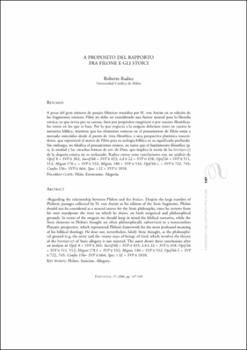A proposito del rapporto fra Filone e gli Stoici
Autor
Radice, RobertoFecha
2006Resumen
A pesar del gran número de pasajes filónicos reunidos por H. von Arnim en su edición de los fragmentos estoicos, Filón no debe ser considerado una fuente neutral para la filosofía estoica, ya que revisa por su cuenta, bien por propósitos exegéticos o por razones filosóficas, los textos en los que se basa. Por lo que respecta a la exégesis debemos tener en cuenta la narrativa bíblica, mientras que los elementos estoicos en el pensamiento de Filón están a menudo sometidos desde el punto de vista filosófico, a una perspectiva platónica trascendente, que representó el marco de Filón para su teología bíblica en su significado profundo.
Sin embargo, no falsifica el pensamiento estoico, en tanto que el fundamento filosófico (p. ej. la unidad y las «muchas formas de ser» de Dios, que implica la teoría de las dunavmei") de la alegoría estoica no es rechazado. Radice extrae estas conclusiones tras un análisis de Opif. 8 = SVF II 302; Sacrif 68 = SVF II 453; LA II 22 = SVF II 458; Opif 26 = SVF II 511, 512; Migrat 178 s. = SVF II 532; Migrat. 180 = SVF II 532; Opif 66 s. = SVF II 722, 745; Confus 156= SVF II 664; Spec. I 32 = SVF II 1010. Despite the large number of
Philonic passages collected by H. von Arnim in his edition of the Stoic fragments, Philon
should not be considered as a neutral source for the Stoic philosophy, since he reviews from
his own standpoint the texts on which he draws, on both exegetical and philosophical
grounds. In terms of the exegesis we should keep in mind the biblical narrative, while the
Stoic elements in Philon’s thought are often philosophically subservient to a transcendent
Platonic perspective, which represented Philon’s framework for the most profound meaning
of his biblical theology. He does not, nevertheless, falsify Stoic thought, as the philosophical ground (e.g. the unity and the «many ways of being» of God, which involves the theory
of the dunavmei") of Stoic allegory is not rejected. The autor draws these conclusions after
an analysis of Opif. 8 = SVF II 302; Sacrif 68 = SVF II 453; LA II 22 = SVF II 458; Opif 26
= SVF II 511, 512; Migrat 178 f. = SVF II 532; Migrat. 180 = SVF II 532; Opif 66 f. = SVF
II 722, 745; Confus 156= SVF II 664; Spec. I 32 = SVF II 1010.





